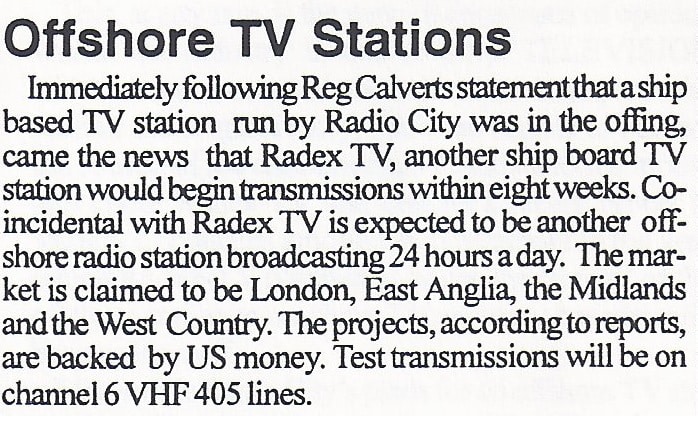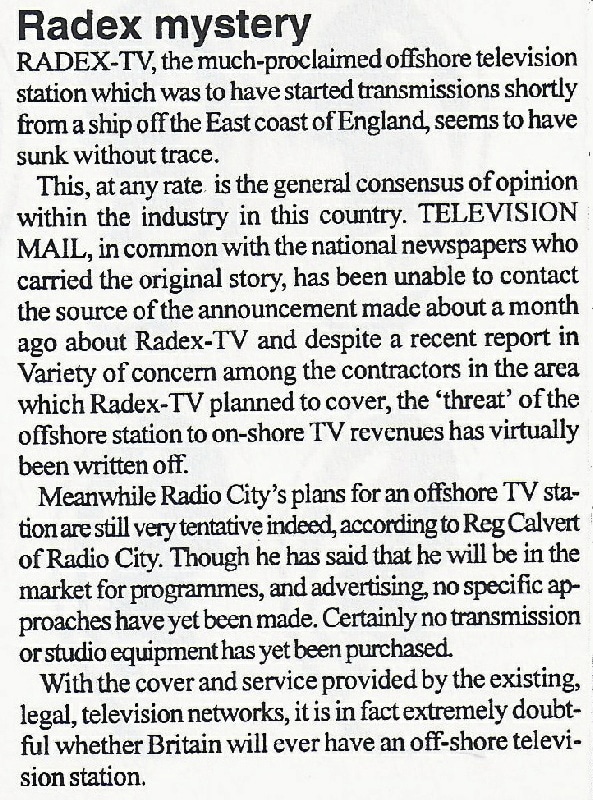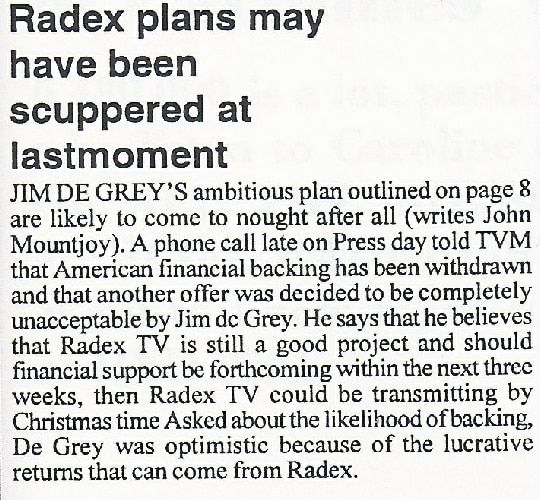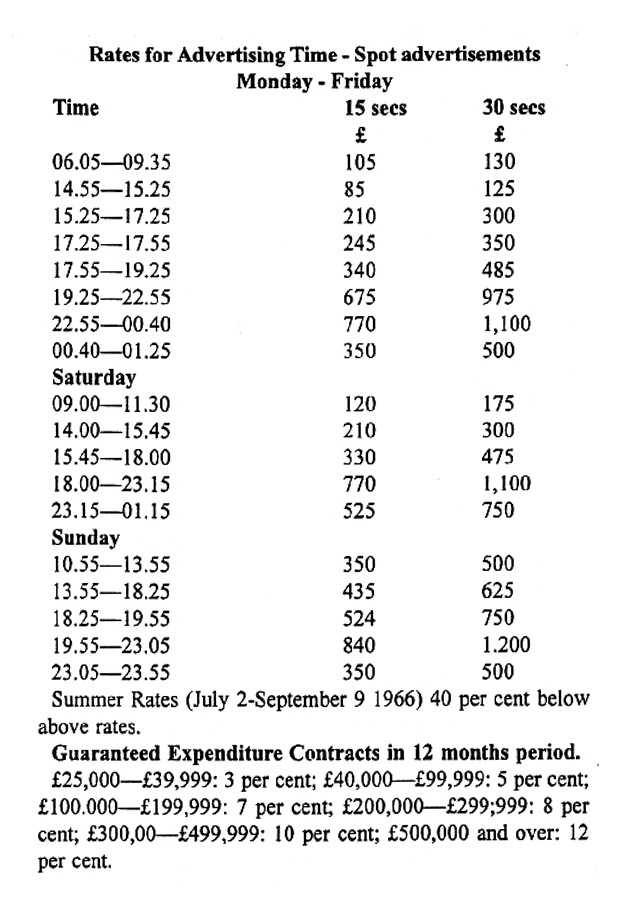A memory of Radio Syd, the organisation run by Britt Wadner, recurred that she and her team were also planning to provide television broadcasts from the Cheeta II. In my mind, along with many others, it seems an impossibility to receive such broadcasts from a ship in good condition. Partly given that a transmitting ship may have been at anchor but still in constant motion.

But on 3rd and 4th of June 1965, through a number of publications, another interesting reason was added to prevent such broadcasts. At issue in that case was the planned broadcasts of a new organisation that promised to go on air 24 hours a day with radio programmes and also wished to provide television broadcasts for 12 hours a day under the name Radex TV.
The Telegraaf reported that, in the opinion of experts, this commercial station would be heard and seen in London, western Netherlands to Amsterdam, northern France and throughout the Belgian coastal area. It was also thought to reach much of south-east England with the use of three transmitter ships. These would be anchored in international waters, with the TV transmitter ship anchored offshore off Whitstable. Two other ships would also have transmitters where they would provide relay of the programmes. One ship off Harwich in Essex and the other off the Isle of Wight.

Channel 6 was indicated as the channel to be used. Days after the initial publication regarding the plans, a warning was issued that any broadcasts by Radex TV via the aforementioned channel would cause serious problems for British space research. What was the case? It was precisely channel 6 that was also used by British Radio Astronomy. The remarkable thing about this was that the government had already twice issued a warning to two other organisations instructing them never to use channel 6. These were the television arm of the BBC and that of commercial television ITV.
Professor Martin Ryle, director of the radio astronomy service in Cambridge, reportedly said, “If this station comes on air at the same time we are working, we just can’t work. We use two big radio telescopes and one of them would be put out of action. I am absolutely appalled at the incredibly lax action Western Europe is taking against these pirate stations. People just don’t seem to care. I am very worried about all this.
An official from the GPO reported that unfortunately it was impossible for the UK government to bring any broadcasts to an immediate end. He was referring to the fact that the three ships to be used would be in international waters and ‘flying’ a ‘foreign’ flag. However, he did add that it was likely that the minister responsible for GPO would put pressure on the UK House of Commons after Whitsun and insist on ending all activities of the so-called ‘pirate broadcasters’.
The organisation behind Radex TV was not alarmed, stating that they had at their disposal a sum of £10 million and with that amount they could hold out for at least a year. £100 in 1965 corresponds in purchasing power to about £2,426.60 in March 2024, an increase of £2,326.60 in 59 years. The pound had an average annual inflation rate of 5.55%. The Radex TV spokesman also reported that they would be targeting a potential 5 million viewers in southern England and that anyone, in possession of a television set, could receive the signal and also did not need to convert the set.
Organisers had also thought in advance not to come up with an abundance of advertising as they announced that this was going to be a maximum of four minutes per broadcast hour. In terms of programming, they stated that these were mainly American productions and 90% of them were delivered on videotapes, a new product for the time and only used in the professional sphere.
Radex TV’s programmes included the then innovative idea of a two-hour breakfast show from 7am, after which broadcasts would resume at 3pm and continue until 1.30am. And finally, they announced that there was also going to be a, its own, news bulletin. Radex’s spokesman in Britain was Jim de Grey, an engineer from New Zealand. He claimed that the organisation could have obtained registration in the Bahamas, strangely part of the great British empire.

Another day later, more came out: People were going to use a 1250-tonne ship that would be fitted out for the task in a port in the British capital. It was a former cargo ship registered in Panama. The television station would have a power of 35 kW, with only British companies being allowed to advertise on the station.
Yet for the benefit of viewers in mainland western Europe, special equipment would be used to rebroadcast the programmes via the so-called 625 line system, while in Britain it would be broadcast via the 405 line system. However, the Telegraph did report having inquired with government agencies in The Hague, which had revealed that any station, anywhere in the world, would be prohibited from broadcasting television programmes without an authorisation from the government as to which countries the programmes would be directed at.
Divergent information regarding the channel to be used also followed as it was suddenly stated that channel 9 was in the planning. The radio broadcasts, with no power of the transmitter mentioned, would be beamed on the 288 or 294 metres. It was also stated that two deejays had already been employed for the radio station, including a female, Mrs. H. Mercedes. A day later, the first criticisms could be read in the various newspapers. One of the articles stated that Radex TV would launch within eight weeks and that bet radio station would broadcast 24 hours a day.
Again a few days later, a notice could be found stating that daily programmes would start in August and would run from 6 to 9 in the morning, 12 to 3 in the afternoon and from 5 in the afternoon to midnight. The cost of a commercial would be around 1,200 pounds per 30 seconds.

As crew, Americans, Canadians and Brits alike would have signed contracts. The idea, it emerged a few weeks later, had come from 49-year-old James De Grey, a New Zealander, who had gained experience at various US television companies. In an interview, he suddenly declared that the television station would broadcast 18 hours a day and that, moreover, they would abide by existing ITV rules, which allowed commercial television stations to carry up to a maximum of six minutes of advertising time per hour.
A direct associate of De Grey, Michael Williams, who had gained his experience in the British National Film Industry, also spoke: “In total, we have spent two years researching to make Radex TV a reality, but we may want to hold off on launching it as we are prepared to make an official licence application for the fourth national network to be launched, which may be run on a commercial basis (later Channel Four, which only started in 1982). If such an application will not be granted, it will have nothing to stop us from coming up with Radex TV after all. We have taken legal advice and we will without question on our plans.”
This already showed that Radex TV was unlikely to happen. De Grey went further about his plans: “If we go on air, we will definitely not advertise cigarettes. We will also start paying tax on our income in England, although our company will not be registered as a UK one. We will make payments as we do not want to hold anyone against us without question. We have appointed a Board of Directors for the venture but will not disclose the names yet. Although we have enough money to start bet project, we will wait until other committed capital is credited to on our account.”
As always, the Algemeen Handelsblad, the predecessor of the Algemeen Dagblad, had a little something extra to report. And that was that the television station would have a power output of 50 kW which could reach a potential of 5 million viewers. Forty crew members would work on the ships, in rotation. At the end of July 1965, it was announced by the organisation that they would look for another frequency and that it could only be a few weeks before the television station would be on air.
On the 26th of August, everyone was helped out of the dream when newspapers reported that the project had been shelved as they were facing problems, the main reason being that the channel, on which Radex TV was to broadcast, was for astronomical and space research.
Two more times we heard Radex TV and Radio project. The first time in early September 1965 when it was announced that five major investors from America had pulled out and the second time was in late October that year when it was announced that the launch of Radex Radio would take place in January 1966 and that of Radex TV in spring 1966. However, the spring sun never rose for the Radex project.
The above article is an expanded version of the article published by Hans Knot in 2009 regarding the Radex radio and television project.
